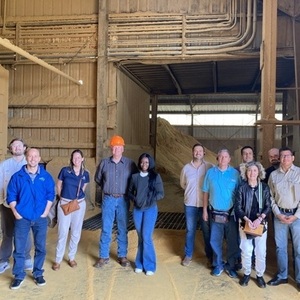Nutritionists from Mexico, Latin America learn latest on DDGS



SOURCE: U.S. Grains Council
June 2, 2022
BY U.S. Grains Council
U.S. Grains Council staff traveled with a group of nutritionists from Mexico and the Latin America region in May on a program built to increase their awareness of distiller’s dried grains with solubles (DDGS) and the new technologies used in the ethanol industry to create value-added co-products, culminating in participation at the Distillers Grains Symposium in Omaha, Nebraska.
Led by Ana Ballesteros, USGC marketing director in Latin America; Patricia Esqueda, USGC marketing specialist in Mexico; and Imby Abath, USGC manager of innovation and sustainability, the group included nutritionists from Colombia, Ecuador and Mexico working in aquaculture and a variety of livestock species.
Throughout the symposium attendees heard from industry experts, including Paige Stevenson, USGC manager of global trade, on DDGS production in the United States, including deep dives into grain and co-product updates, sustainability and nutrition for feed products.
Advertisement
“The participants particularly enjoyed the nutrition-oriented sessions during the symposium and considered most of the information they heard to be relevant to improving their understanding of the industry and its products,” Ballesteros said.
Outside the symposium, the group visited the ethanol facilities of two Council members: Chief Ethanol Fuels Inc., and Green Plains Inc. At each plant, participants learned more about the on-site dry milling facilities and the new technologies being used to update and enhance DDGS to best meet the needs of specific species. Visiting the ethanol plants and attending the symposium contributed to the group leaving interested in exploring how to use these new products in their formulations, which was the program’s goal.
“The participants in this group had not had opportunities to visit an ethanol plant before, so it was very interesting for them to have a better understanding of how regular DDGS and new technology DDGS are produced,” Esqueda said. “For the members of this group, it was very important to know the processes and to know that there is good quality control that allows the consistency of the product to be maintained, making it safe for shrimp and other aquaculture diets, as well as for other species, as the participants could verify during the symposium.”
Advertisement
Mexico is the seventh-largest market for shrimp production in the world. The country represented more than 18 percent of all U.S. DDGS exports in 2020/2021, at 2.1 million metric tons.
Additionally, since marketing year (MY) 2015/2016, DDGS exports to Latin American have grown continuously, from 468 thousand metric tons (TMT) to 690 TMT in MY 2020/2021. Colombia is the largest export partner in the region with a 40 percent share of total exports, while exports to Ecuador grew almost 10 times in this same period, from 5.6 TMT to 52.5 TMT.
Related Stories
Neste Corp. on July 24 released second quarter results, reporting record quarterly renewable product sales volumes despite weaker margins. SAF sales were up nearly 80% when compared to the first quarter of 2025.
Valero Energy Corp. on July 24 released second quarter results, reporting a profitable three-month period for its ethanol segment. The renewable diesel segment posted a loss, but the company’s new sustainable aviation fuel (SAF) unit operated well.
The IRS on July 21 published a notice announcing the 2025 calendar-year inflation adjustment factor for the Section 45Z clen fuel production credit. The resulting adjustment boosts maximum the value of the credit by approximately 6%.
U.S. Secretary of Agriculture Brooke L. Rollins today announced the reorganization of the USDA, refocusing its core operations to better align with its founding mission of supporting American farming, ranching, and forestry.
The U.S. Department of Energy’s Office of Energy Efficiency and Renewable Energy is soliciting public comments on a preliminary plan for determining provisional emissions rates (PER) for the purposes of the 45Z clean fuel production credit.
Upcoming Events










